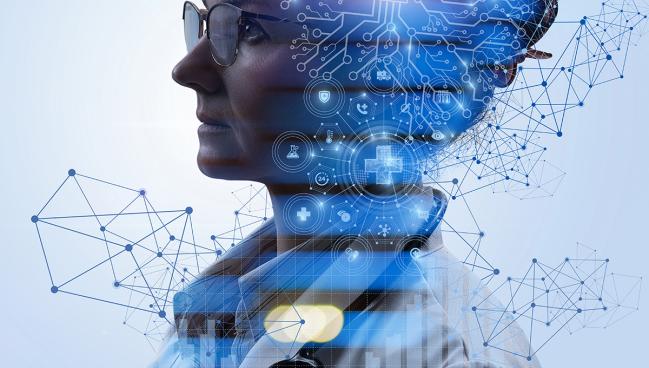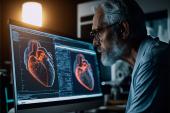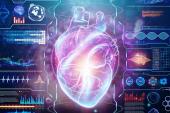AI Expected to Augment Workload, Not Put Cardiac Imagers Out of Work
AI and machine-learning algorithms will take on many tasks, but humans will have to contextualize the results, experts predict.

WASHINGTON, DC—Artificial intelligence (AI) and machine-learning (ML) algorithms will lead to an evolution, but not an elimination, of the roles physicians play in interpreting coronary CT scans, experts largely agreed during discussions held here at the recent 2024 Society of Cardiovascular Computed Tomography (SCCT) meeting.
During a debate on whether AI will make cardiac radiologists and imaging cardiologists “redundant” within a decade, Manish Motwani, MBChB, PhD (Manchester University NHS Foundation Trust, England), argued on the “pro” side, but he acknowledged there will remain a need for human oversight.
AI/ML algorithms will likely take on menial tasks, providing prepackaged and processed results from coronary CT angiography (CCTA) that will then be delivered to a clinician, he said.
“We will probably be contextualizing those images rather than manually reporting,” Motwani said. “So we will have a lot of data, we’ll have a lot of preformatted images, and there may be some completely normal ones that will whisk through our software and programs and be dealt with and there will be some that we have to put into context based on AI-processed images.”
Koen Nieman, MD, PhD (Stanford University, Palo Alto, CA), Motwani’s debate opponent, agreed that that likely strikes the right balance, saying the technology will be like a co-pilot, one that “does not replace the comprehensive interpretation and communication that cardiac [imagers] can provide.”
AI/ML Is the ‘Gift of Time’
In arguing that AI technology will take much of the workload of cardiac imagers away within the next 10 years, Motwani noted that these algorithms can already do much of what is needed: accurately evaluate a CT scan, offer extensive insights into not only stenosis but also myriad plaque characteristics, and provide an actionable report of the scan findings.
In the broader sense, evolution has shown that the key to survival is adaptation, and “CT must evolve from ‘human reads’ to survive,” Motwani said. “Fortunately, we have developed AI algorithms, and as you’ve seen throughout this meeting . . . they are implemented at every step of the CTA workflow.” Pointing to their use in areas such as segmentation, quantitation, prognosis, and diagnosis, he said: “These algorithms are now so good you can’t ignore them.”
Why are you wasting [time] with menial tasks? Let the robots do their thing. Manish Motwani
Importantly, AI provides “the gift of time,” he said, citing one study showing that over an 8-hour shift, a radiology resident evaluating scans had their mouse cover the equivalent of 1.37 miles on the computer screen, with 10,778 keystrokes (23 per minute). It took about 30 minutes to process one scan.
Allowing AI to perform some of these processes in seconds rather than minutes could save several hundreds of hours for physicians each year. “Time is our most precious commodity,” Motwani stressed. “Why are you wasting it with menial tasks? Let the robots do their thing.”
This is especially critical at a time when there are major shortages of radiologists in many countries, he argued. For instance, data from the United Kingdom showed that only 2% of radiology departments have enough staff to fulfill imaging reporting requirements during contracted hours. “This gap has to be filled by AI. There’s no other choice,” he said.
And finally, there are economic tailwinds driving the adoption of AI/ML in medical imaging, which is currently an $8 billion industry, Motwani said. “There’s money to be made in AI. There’s money to be saved in AI. Capitalism always wins.”
Cardiac Imagers as Interpreters and Communicators
Nieman countered by saying he agrees with Motwani on many things, highlighting the ability of AI/ML to perform tasks that can be tedious for physicians. AI/ML can more easily take various measurements, automate vessel extraction and display, and improve image acquisition and reconstruction, for example.
But the idea of delegating certain tasks to others is not a new one for cardiac imagers, who are in short supply, Nieman said. And outsourcing will remain a necessary part of the job as the aging population requires more and more tests, protocols become more complicated, and there are an increasing number of imaging-guided procedures performed, he added.
AI is not a perfect fix for all of these issues, however, Nieman argued. These algorithms perform well, but always in limited, selected populations, and there’s no guarantee they’ll perform well in other settings, he said, pointing out that there will also be rare conditions that were not factored in when the algorithms were being developed.
Other issues that need to be considered are the costs of the technology, who is ultimately accountable for them when they’re used in practice, and the “junkyard of data” that will grow even larger with generative AI, Nieman said.
We provide a comprehensive interpretation that includes a lot of different things, not just that one-line single task that needs to be done. Koen Nieman
The bottom line, he said, is that AI/ML technologies come in the form of computer algorithms and applications, similar to what imagers have been using for a long time while they integrate other information about a patient’s status.
“I think that’s where cardiac imagers are irreplaceable. We provide a comprehensive interpretation that includes a lot of different things, not just that one-line single task that needs to be done,” Nieman said, stressing, too, the key role physicians play in communicating findings. “I think we will stay relevant to actually translate this kind of information and make it understandable for our patients, and that’s a role that I do not see being replaced.”
Ultimately, he said, “imaging has always thrived on technological advancement and delegation of tasks. This is not something new and this will continue and this will actually make us more productive and let us go home on time.”
AI/ML Isn’t Going Anywhere
Asked to comment on what cardiac imagers will be doing in 10 years, Andrew Choi, MD (George Washington University School of Medicine, Washington, DC), told TCTMD, “I feel extremely secure in my job as a CT imager after this meeting, after hearing about all of the AI/ML technologies. He pointed to the vast problem of coronary disease in the population.
Choi said AI/ML offers clinicians “an augmented approach” to patient management. The technology, he added, “is going to help us fill in the gaps in inequitable care and access that we have to be able to get CT-based approaches, CT diagnosis, into areas of the country and into areas of the world that don't have access to it.”
The AI/ML-focused sessions at the SCCT meeting were meant “to equip ourselves to understand both the disruptive nature of the technology and its potential,” Choi said.
Like others, he highlighted the time savings that AI/ML can provide, but he also underscored the rapid comprehensive analysis of scans that is possible with the technology and how that can help human readers. “Whether it is a combination of plaque, flow, stenosis, or inflammation,” said Choi, “we're getting closer to being able to do it in a comprehensive way, but needing the expert clinician, needing the CT imaging clinician, to guide and filter what is important in that data. . . . We still have to shape it.”
This isn't a replacement. This is an augmentation, an addition, and humans need to be front and center. Michelle Williams
Tessa Cook, MD, PhD (University of Pennsylvania, Philadelphia), who gave a talk on the ethics of using AI/ML in CCTA, agreed that the technology will not eliminate the need for cardiac imagers. “AI is certainly going to be able to augment or potentially replace some of the tasks that we do today, but I would argue that we are, as the expert clinicians . . . and scientists, responsible for how best it should be used for our patients,” she emphasized.
But the roles of physicians will evolve, she argued. “Those of you that have been doing this longer than I have have seen the evolution up to this point. And now with AI, we're going to see evolution that continues. But I maintain that this process only succeeds if we are involved in it, and we have to actively engage on behalf of our patients.”
Michelle Williams, MBChB, PhD (University of Edinburgh, Scotland), in another talk, predicted that AI/ML will be a tool that imagers use every day to perform routine tasks, allowing them to spend more time interacting with patients and their colleagues. The technology also has the potential to improve teaching and research, she added.
“But fundamentally, humans have to be central to everything we do,” Williams said. “This isn't a replacement. This is an augmentation, an addition, and humans need to be front and center.”
Todd Neale is the Associate News Editor for TCTMD and a Senior Medical Journalist. He got his start in journalism at …
Read Full BioSources
Multiple presentations. Presented at: SCCT 2024. July 19-20, 2024. Washington, DC.
Disclosures
- Choi reports consulting fees/honoraria from Siemens and stock options from Cleerly.
- Nieman reports receiving unrestricted institutional research support from the National Institutes of Health (NIH)/National Heart, Lung, and Blood Institute, Siemens, and Novartis; consulting for Novartis, Cleerly, and Artrya; and having equity in Lumen Therapeutics.
- Cook reports grant funding from the American College of Radiology, the NIH, and IBC and honoraria from the British Journal of Radiology and Quattro.
- Williams reports being on the speakers bureau for Novartis.
- Motwani reports no relevant conflicts of interest.





Comments